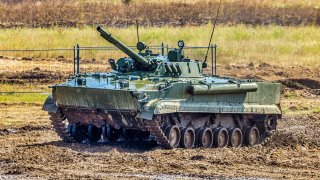BMP-3 'Tank Destroyer' Could be Russia's Mobile Drone Carrier
The Soviet-era BMP-3 infantry fighting vehicle, developed at the end of the Cold War, is set to evolve into a mobile drone carrier. Russian state media reported that mini-drones are being integrated into the BMP-3, enhancing its capabilities as a multifunctional combat platform.
Summary and Key Points: The Soviet-era BMP-3 infantry fighting vehicle, developed at the end of the Cold War, is set to evolve into a mobile drone carrier. Russian state media reported that mini-drones are being integrated into the BMP-3, enhancing its capabilities as a multifunctional combat platform.
-The BMP-3, which serves various roles including as a tank destroyer and amphibious personnel carrier, will now gain added flexibility with drone warfare capabilities, potentially transforming it into a mobile drone command station.
-This development highlights the increasing use of drones in the ongoing conflict in Ukraine, where both Russian and Ukrainian forces have leveraged unmanned aerial systems.
Russia's BMP-3: The Next Frontier in Mobile Drone Warfare
Developed at the tail end of the Cold War, the Soviet-designed BMP-3 has served as a multifunctional mobile combat platform –including an infantry fighting vehicle, mobile command center, tank destroyer, fire support vehicle, and even an amphibious personnel carrier.
It could soon serve in another capacity, as a mobile drone carrier.
According to a report from Russian state media outlet Tass on Thursday, mini-drones may be added to the arsenal of the BMP-3.
"The work to introduce drones into the armament of armored vehicles is one of the tasks for specialists of SKBM [Special Design Bureau of Machine-Building] at present," the press office of the High Precision Systems Holding Company, a subsidiary of the state tech military-industrial conglomerate Rostec, told TASS.
"Currently, draft organizational decisions and a schedule of joint work for integrating mini-UAVs into the BMP-3 infantry fighting vehicle are being agreed upon. Drones are planned to be introduced into the design documentation of armored vehicles after the results of type testing," the press office added.
Drone Warfare
Both Moscow and Kyiv have increasingly employed drones in the ongoing fighting in Ukraine, and while the unmanned aerial systems can be operated from safe distances behind the battlefield, range has still been an issue. Operating the drones and loitering munitions from mobile platforms could provide greater flexibility in their deployment.
Rostec had previously indicated it was exploring options to integrate first-person view drones as a component of the armament for light armored vehicles but never stated what platforms that could include. It would now appear that the BMP-3 would be among the vehicles that are well-suited to the role.
The BMP-3 in the Crosshairs
Developed by the Special Design Bureau of Machine-Building and produced at Rostec's facility in Kurganmashzavoid, the BMP-3 (Boevaya Mashina Pekhoty-3) was developed to replace the aging BMP-1 and BMP-2 infantry fighting vehicles. The BMP-3 infantry fighting vehicle variant is armed with a 100mm cannon-missile launcher and 30mm automatic cannon. Secondary armament consists of a 7.62mm machine gun at the main weapons station, with two additional MGs located in the hull.
The IFV is operated by a crew of three and can carry upwards of eight troopers. The amphibious vehicle has a top road speed of 70 km/h (43 mph) and a top floating speed of 10 km/h (six mph). The cruising range of the BMP-3 IFV was about 600 km (372 miles). It is reported to weigh 18.7 metric tons.
The BMP-3 has earned comparisons to the U.S. military's M2 Bradley Fighting Vehicle. More than 2,000 have been reported to have been built and it was first employed in combat in the First Chechen War. In the ongoing conflict in Ukraine, the BMP-3 has been increasingly employed in an indirect fire support role – but soon could be a mobile drone command station.
Author Experience and Expertise: Peter Suciu
Peter Suciu is a Michigan-based writer. He has contributed to more than four dozen magazines, newspapers, and websites with over 3,200 published pieces over a twenty-year career in journalism. He regularly writes about military hardware, firearms history, cybersecurity, politics, and international affairs. Peter is also a Contributing Writer for Forbes and Clearance Jobs. You can follow him on Twitter: @PeterSuciu. You can email the author: [email protected].
Image Credit: Shutterstock.


